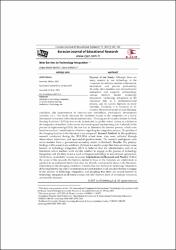| dc.contributor.author | İzmirli, Özden Şahin | |
| dc.contributor.author | Kırmacı, Ömer | |
| dc.date.accessioned | 2021-12-12T16:49:46Z | |
| dc.date.available | 2021-12-12T16:49:46Z | |
| dc.date.issued | 2017 | |
| dc.identifier.issn | 1302-597X | |
| dc.identifier.issn | 2528-8911 | |
| dc.identifier.uri | https://app.trdizin.gov.tr/makale/TWpjeE1URTBOQT09 | |
| dc.identifier.uri | https://hdl.handle.net/20.500.11857/2094 | |
| dc.identifier.uri | https://doi.org/10.14689/ejer.2017.72.8 | |
| dc.description.abstract | Purpose of the Study: Although there are many reasons to use technology in the classroom (to enhance student achievement, motivation, and process productivity; diversity offers teachers new alternatives for instruction and supports self-learning), various integration. Technology integration in the education field is a multidimensional process, and its success depends on many variables. Therefore, it is necessary to reexamine the barriers under several changing conditions (the improvement of infrastructure possibilities, professional development activities, etc.). This study discusses the problems related to the integration of a newly introduced web system with educational activities, “Tracking and Evaluation System for Book Reading Activities” (KITaS), that would be included in a public school system, in addition to the integration of teachers in the course of promoting and implementing it in Kırklareli. In the process of implementing KITaS, the aim was to determine the barriers present, which were based on teachers’ considerations of barriers regarding the integration process. The profiles of the changing barriers in the literature were compared. Research Method: In this qualitative research conducted during the 2015–2016 school term, data were collected through observations, interviews, and open-ended question forms. The research participants were seven teachers from a government secondary school in Kırklareli. Results: The primary findings of this research are as follows: (A) there is a need to accept that there are always some barriers to technology integration; (B) it is believed that the administrative unit of an institution where teachers work decides whether to engage in the process of technology integration, and (C) there is not a need to integrate technology in test-centered approaches, which focus on students’ success on exams. Implications for Research and Practice: Within the scope of this research, the barriers similar to those in the literature are established, in addition to an additional barrier that does not directly correspond to those in the literature. Depending on the changing conditions, it seems that new barriers to technology integration (believing that the top unit of an institution at which teachers work decides whether to engage in the process of technology integration, and accepting that there are several barriers to technology integration at all times) emerge and other barriers (lack of technology resources) are found to decrease. | en_US |
| dc.language.iso | eng | en_US |
| dc.relation.ispartof | Eurasian Journal of Educational Research | en_US |
| dc.identifier.doi | 10.14689/ejer.2017.72.8 | |
| dc.rights | info:eu-repo/semantics/openAccess | en_US |
| dc.subject | Eğitim | en_US |
| dc.subject | Eğitim Araştırmaları | en_US |
| dc.title | New Barriers to Technology Integration | en_US |
| dc.title.alternative | Purpose of the Study: Although there are | en_US |
| dc.type | article | |
| dc.department | Rektörlük, Rektörlüğe Bağlı Birimler, Uzaktan Eğitim Uygulama ve Araştırma Merkezi | |
| dc.identifier.volume | 17 | en_US |
| dc.identifier.startpage | 147 | en_US |
| dc.identifier.issue | 72 | en_US |
| dc.identifier.endpage | 165 | en_US |
| dc.relation.publicationcategory | Makale - Uluslararası Hakemli Dergi - Kurum Öğretim Elemanı | en_US |
| dc.identifier.wos | WOS:000423268400008 | en_US |
| dc.identifier.scopus | 2-s2.0-85039863538 | en_US |



















